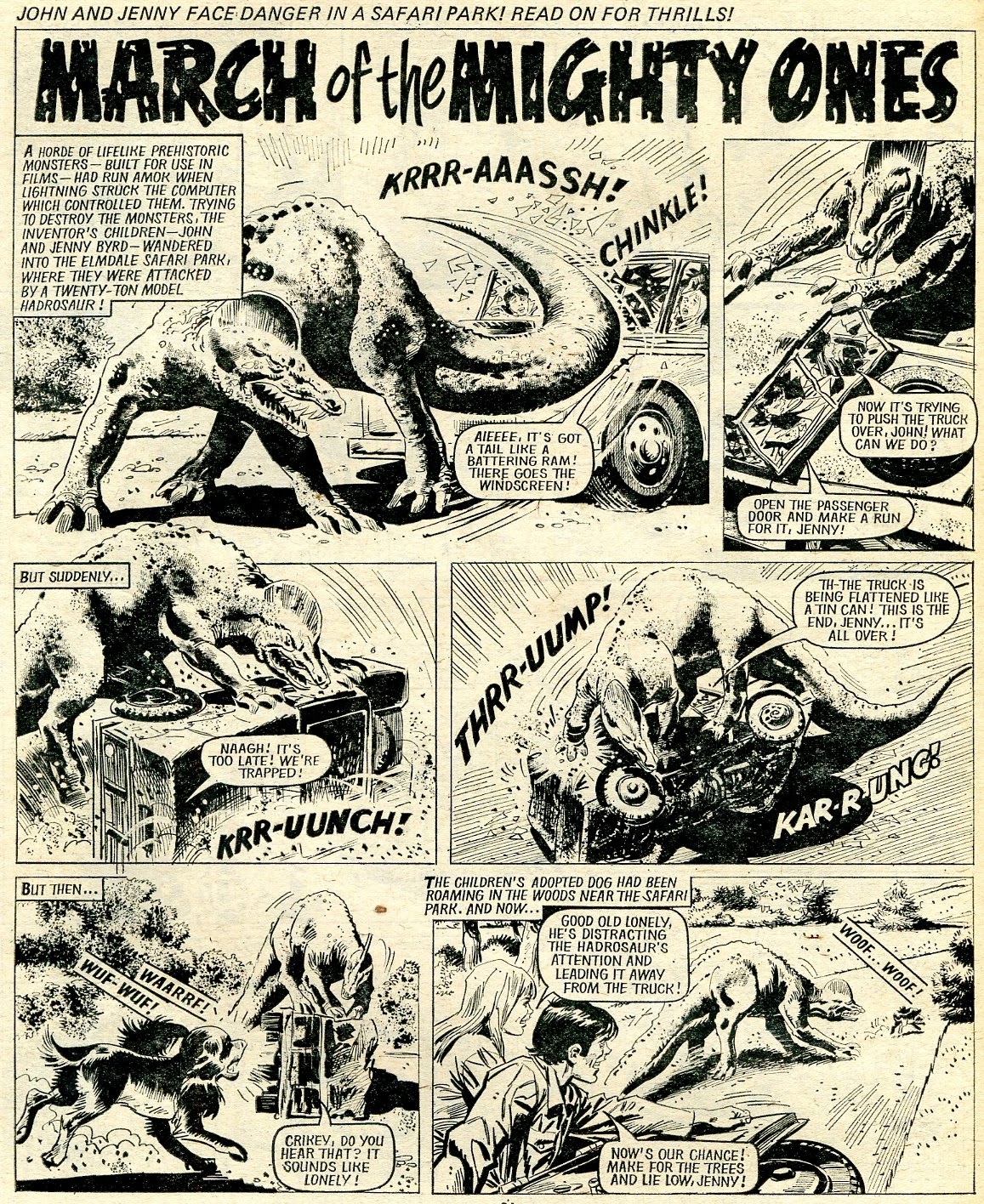Next in
line is another excellent example of the comedy horror genre. In the introductory
episode of Major Jump Horror Hunter in MFC No. 1 we meet Major Jump –
owner of a large estate who realises that the only way he can keep it going is
by opening it to the public and making it into a monster menagerie. His original
idea is to catch and exhibit some big exotic animals, and in Major Jump’s vocabulary
‘monster’ means ‘big’ – at first he doesn’t even believe in real monsters. The Major
owns a special flying craft that can go anywhere, now all he needs is a ‘willing
lad assistant’. Enter Cosmo Crumpet – a daft bespectacled young man, and his
pet Meredith – a real monster creature who looks like a big fat slug. This
comes as a shock and a revelation to Major Jump – if monsters do exist, he can
make it a real monster menagerie! Meredith
is hired as the keeper of the future monster zoo, while the newly-converted
believer in monsters Major Jump sets off on his first monster hunt accompanied
by his freshly-employed assistant Cosmo:
This looked
like a nice idea for a strip but having read the second episode I was a bit disappointed:
Major Jump and Cosmo got a phone call from a Scottish gent who complained there
was a monster mouse lurking around his house. They rushed to Scotland and set a
monster trap for the creature, only to discover the hard way it was not a giant
mouse but a giant moose. The gag was OK, but I thought, oh no, are they going
to screw this up by doing another version of Ghoul Getters Ltd, only
with monsters instead of ghosts?!. Ghoul Getters Ltd. was a super strip
that originated in SHIVER AND SHAKE and continued in the combined WHOOPEE!
& SHIVER AND SHAKE, but doing another feature with ghost-/monster-busting
as the main theme would be lazy, I thought. I am glad my concerns proved to be
wrong. In the comming weeks Major Jump and Cosmo went on many an exciting expedition
to faraway lands looking for all kinds of monsters with crazy names such as the
1003 –Eyed Monster, the Australian Elastic-Pouch Kanga-Wanga, the Blundering Backwards Galloper, the Two-Headed Bombay Pompadonkle, the Great Spotty-Nose Twittyclot, the Sneaky Wikiki-Freaki, the
Great Polar Elephant Seal, the Terriblosaurus, the Nagasaki Nosher, the
Fabulous Foozlum Bird, etc. The hunt involved the use of an arsenal of silly disguises
and traps as well as a hypodermic syringe loaded with tranquilizer. Major Jump
was usually the one who designed the wacky monster-catching schemes and the
poor Cosmo had to do all the tricky work.
Although the
schemes frequently misfired and landed the two monster hunters in trouble, the
menagerie was soon chock-full of weird creatures. What I like about the strip
is that it didn’t become repetitive by focusing on monster-hunting adventures
but alternated between the expeditions and daily life at the zoo. Check out
a couple of examples below. The one about benefit tourists is my favourite:
In issue 56
Major Jump and Cosmo captured the Horrendous Heeblyjeebie – the ugliest monster
of them all. It was so hideous they had to keep its face covered, which
prompted the announcement of a one-off participation feature offering five £1
prizes to authors of Heeblyjeebie’s best portraits. It isn’t clear who
announced the competition but it looks like it was Major Jump himself. The
Horrendous Heeblyjeebie was also seen in the next week’s episode (in MFC No.
57), here are both sets in sequence:
The five
best portraits were printed in MFC No. 66 and the lucky winners must have been
delighted to discover that for some reason their £1 prizes had been doubled:
It appears
that initially the illustrator was Ian Knox, although none of the episodes were
signed (as opposed to Terror TV – Ian Knox’s other strip
in MFC, of which only a few episodes weren't signed). Starting from issue
No. 34 another artist who I believe is Barrie Appleby took over. The one-pager
ran in MFC issues 1 – 72 and missed issue Nos. 15, 25, 31, 39, 51, 52, 55, 58,
61 and 65. All sets were in black and white except for the full-colour episode
on the back cover of MFC issue No. 67.
All in all,
Major
Jump Horror Hunter was a witty, well-written and beautifully presented
strip but there are two things I find disappointing about it. Firstly – I think
it deserved a proper ending (the feature did not make it to the combined BUSTER
AND MONSTER FUN and disappeared without a warning after the penultimate MFC
edition). Secondly, I think it would
have been great if they had shown the Horrendous Heeblyjeebie’s real face…
Come back
soon for a look at the hideous Creature Teacher!


























